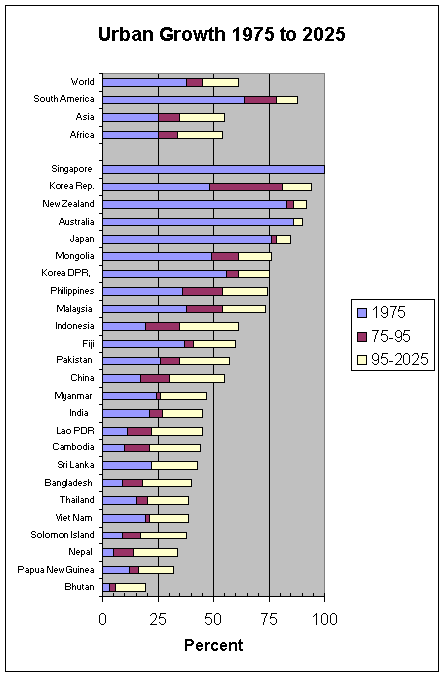In many developing country cities, the focus of urban forestry must be on contributing to fulfilling the immediate requirements for basic products. Less essential, yet also important, is urban green space for recreation. Forests need to respond to the wide range of needs by optimising combinations of locally accepted priorities, values and expectations.
The value of the forest is increasingly recognised as extending beyond rural areas and so trees must become compatible with and functional in the urban environment. This working paper examines the present status and the future prospects of urban forestry in the Asia-Pacific region. The objective is to make policy makers, foresters, urban planners and general public more aware about the essential role which urban greening can play to make cities more liveable, particularly in resource-poor settlements.
The paper is deliberately biased towards (i) urban forest needs of poorer cities and vulnerable groups; (ii) urban forestry in a more restricted scope, i.e. trees within built environments and (iii) promising innovative urban forestry-related approaches relevant to the region. This paper provides basic information on the benefits, challenges and approaches and requirements of planning, managing and conserving urban forests.1 Urban forestry is not yet really recognised as a development issue probably due to ignorance; therefore much more in-depth information on the state-of-the-art in the region is required.
Asia will be predominantly urban in the future. While most attention is given to mega-cities, the process of urbanization affects all cities. Urban areas of all sizes have important roles to play. Hence, urban policy should not necessarily concentrate on cities of any specific size. The development focus should be on poor cities and on poor people in more affluent cities. |
Urbanization is a global phenomenon, although the degree of urbanization and the rate of urban growth vary in different parts of the world.2 In 1975, only 38% of the world's population was urban. 25% of the people in Asia were urban. However, in Oceania already more than 70% were urban dwellers. In 1995 the world's urban population increased to 45% and in Asia to 35%. Currently the region is still less urbanized than North Africa (75%), Europe (73%) or Latin America (78%). It has the same level of urbanization as Africa (34%).
Globally, between 1990 and 2025, the number of people who will live in urban areas is expected to double to more than 5 billion people; about 90% of this growth will occur in the developing world (WRI 1996). The Asia-Pacific region will undergo a dramatic change from rural to urban; the trend will continue for several decades (Figure 1, and Annex 1). In the least developed countries (Nepal, Bangladesh), urban growth rates are among the highest. Growth rates are also extremely high in the rapidly industrializing cities, located mostly in Southeast Asia (WRI 1996). Already, ten of the world's larger mega-cities (with populations of 10 million or more) are in Asia; by 2015, the world will have 27 mega-cities of which 17 will be in Asia.
While attention is often focused on the world's mega-cities, they contain a relatively small proportion of all urban dwellers. Today, only about 15% of urban dwellers live in cities of more than 5 million people, while over 60% live in towns and cities of one million inhabitants or fewer (ADB 1996). Indeed, many intermediate-size cities (with populations of between 1 million and 10 million) may actually be growing faster on average than the largest cities, at rates well over 5% per year. Small cities are often especially affected by inadequate investment in environmental infrastructure or services, because many countries direct their resources to the larger urban centres (WRI 1996).
Urban migration might account for between 40 and 60% of annual urban population growth and will be particularly significant in rapidly industrializing regions such as Asia and parts of Africa. China, for example, may see 200 million more rural labourers looking for work in the cities over the next decade (ADB 1996).
Historically, poverty has been concentrated in rural areas but is increasingly also becoming an urban phenomenon. In Asia, large decreases in the proportion of the population living in poverty have been reported for the rapidly growing economies but South Asia is expected to continue to contain a large share of the world's urban poor.
The urbanization of poverty has implications for the urban environment and for the quality of life of the poor, who usually reside on marginal and environmentally sensitive land.
Urban areas generate environmental problems felt at all levels from the household to the globe. These problems range from impairment of human health, economic and other welfare losses, to damage to ecosystems. Air and water pollution and hazardous waste generation are among key problems; conversion of open space and agricultural land to urban development is another problem. Urbanization can reduce water permeable areas, upset natural drainage patterns, and cause serious flooding.
Figure 1. Urbanization trends in the Asia-Pacific Region

One of the most important determinants of a city's environmental problems is its income level. As the wealth of a city grows, many types of environmental degradation first increase and then eventually diminish.
1 The author appreciates very much the assistance and critical review by A. Widanapathirana, Social Forestry Expert, New Zealand, Ceceil Kronijnendijk, Urban Forestry Researcher, European Forestry Research Institute, Finland, Mr. Richard C. Lair Bangkok, and Mr. M. Chipeta, Michelle Gauthier, and other FAO staff.
2 Urban area is the built-up or densely populated area containing the city proper; suburbs, and continuously settled commuter areas. The definition of "urban area" varies from country to country, e.g. in the USA most conservative delineation of urban land requires a population density of 620/km2 (Rowntree 94). In India urban areas have 5,000 inhabitants and in Malaysia 10,000 respectively . (WRI 1996).